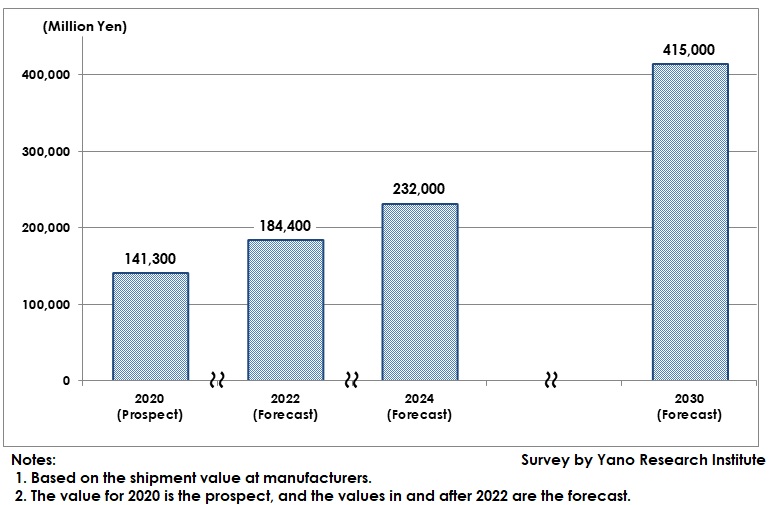No.2739
Global Physically/Chemically Functional Thin Films/Membranes Market: Key Research Findings 2021
Forecast of Global Market Size of Physically/Chemically Functional Thin Films in 2020 Expected to Achieve 141,300 Million Yen
Yano Research Institute (the President, Takashi Mizukoshi) carried out a research on the global next-generation functional thin films market, and found out the seven categories of such films, trends of R&D institutions, and future perspectives. This paper discloses the future forecast of the global physically/chemically functional thin films market.

Market Overview
Whether organic or inorganic, and whatever the material types, a substance thinned to the thickness of several nanometers to some hundreds nanometers sometimes shows different structure or physical property from a chunk of substance. Recently, there have been some development and studies of next-generation high-performance membranes or thin films that have distinct characteristic functions among each other.
This research targets physically/chemically functional thin films and membranes that play unique roles on the surface forming a common boundary of two characteristically different phases. Such functional thin films and membranes include super-water repellent membrane, gas barrier membrane, hydrophobic membrane, super hydrophilic membrane, etc. The global market size of physically/chemically functional thin films/membranes in 2020 is projected to achieve 141,300 million yen, based on the shipment values at manufacturers.
When observing the physically/chemically functional thin films/membranes market by category, super-water repellent membrane occupies the largest share, about 38% of the entire market, followed by gas barrier membrane accounting for around 18%. The next largest is hydrophobic membrane, and then comes super hydrophilic membrane.
Noteworthy Topics
Gas Barrier Membrane
In general, thin films with 1 to 5 micrometers of holes cannot make water, that is liquid, to pass through. On the other hand, gas or vapor has the size of about 0.3 to 0.5 nanometers which can pass through thin films with 1 nanometer of holes, based on the principle of solubility and diffusion.
In addition, there are twenty-first powers of 4 times 10 units of holes per 1 cubic centimeter of a polyethylene film industrially produced. Bags made from such polyethylene films do not make water to pass through but they allow air leakage, preventing them from being completely sealed or airtight.
If any film without any holes whatsoever, not even a tiny hole, gas-barrier properties can be attached to achieve complete airtightness. Because of the lightness, transparency, low in cost, and ability of changing shapes, plastic films are extremely good material for packaging. In order to make sure of airtightness, plastic films are demanded to have gas barrier properties. Therefore, membranes with high gas-barrier performance have been vigorously developed.
Future Outlook
The global physically/chemically functional thin films/membranes market size (based on the shipment values at manufacturers) for 2030 is forecasted to reach 415,000 million yen, 294% of the size of 2020.
When observing the market size by category, hydrophobic membrane in 2030 is expected to achieve the largest growth at 640% of the size of 2020, while super-water repellent membrane which occupied the largest share in 2020, is projected to show the lowest growth rate in 2030, 240% of 2020.
Physically/chemically functional thin films/membranes play unique roles on the boundary surface of different substances. When considering the boundary surfaces, there is distinct difference between bulk substances and thin films/membranes. For bulk substance, boundary surface is only a small part and its behaviors affect only limitedly. On the other hand, boundary surface for a membrane occupies overwhelmingly large part, and its behaviors affect considerably.
Therefore, when considering physical/chemical functions of films or membranes, behaviors of boundary surface must be fully considered.
Various effects are expected from thin films/membranes, but the most notable effect is simply the reduction of thickness. For example, in electronics, the development has been in progress toward thinness, lightness, shortness, and smallness, accelerating the reduction of device sizes. Sizes of modules that comprise device parts are becoming increasingly thinner and smaller, which is making such devices to step into the field of nanotechnology. In addition, significant changes can also be expected in the physical/chemical characteristics that materials possess as the device size scales down, which can bring about tremendous changes. Because such prominent effects can be expressed, there is no stopping of the attempts toward further thinness, lightness, shortness, and smallness, which can be reflect to the development of next-generation functional membranes.
Research Outline
2.Research Object: Research and development institutions, manufacturers, distributors, and retailers of physically/chemically functional thin films
3.Research Methogology: Face-to-face interviews by expert researchers (including online), and literature research
About Physically/Chemically Functional Thin Films Market
Physically/chemically functional thin films in this research refer to functional films that employs the physical/chemical characteristics playing unique roles on the surface facing the boundary of different substances. They include super-water repellent membrane, gas barrier membrane, hydrophobic membrane, super hydrophilic membrane and others (antibacterial membrane, oleophilic membrane, etc.) The market size is based on the shipment values at manufacturers.
<Products and Services in the Market>
Next-generation functional membrane (electric/electronic functional thin films, physically/chemically functional thin films, optically sensing membrane, ceramic thin films, membrane, organic membrane, bio-functional membrane, membranes for environmental-energetic applications
Published Report
Contact Us
The copyright and all other rights pertaining to this report belong to Yano Research Institute.
Please contact our PR team when quoting the report contents for the purpose other than media coverage.
Depending on the purpose of using our report, we may ask you to present your sentences for confirmation beforehand.